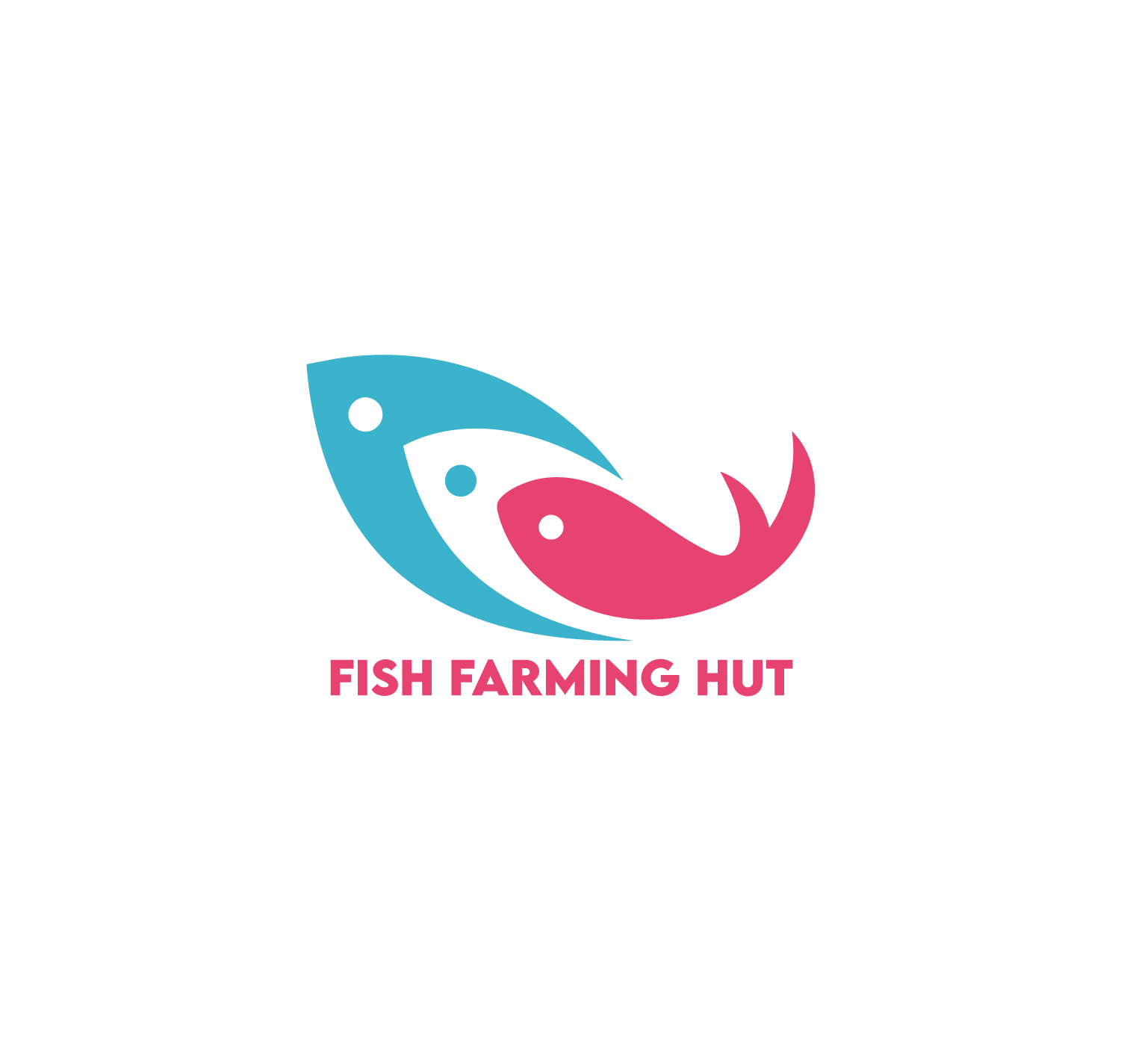If you are thinking of starting a fish farm or are new to the business, choosing the optimal food for the fish in your fish farm can be challenging. The market is saturated with different brands, promising to be the best feed. A friend of mine had this issue a while ago, and I wanted to help him choose the best feed for his fish farm.
When you choose a fish feed that is best for your fish farm, you will need to look at a few factors to make an informed decision. Some of the factors include the type of fish you have, the cost of the feed, the age of your fish, and quality fish feed that has a balanced nutritional composition.
My friend was unsure what product to choose from and the nutrition his fish would need to grow healthy. The production of fish food has taken dramatic leaps forward in the last decade, and more species-specific feeds have been developed. I know other fish farmers could benefit from the information we gathered, and I will share it in this post.
How To Choose Fish Feed That Is Best For A Fish Farm
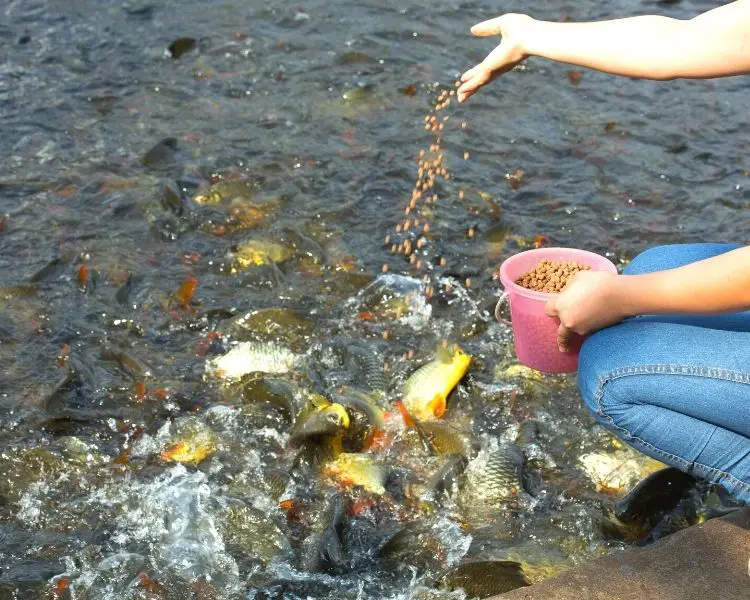
Providing good nutrition is essential to the economical production of high-quality, healthy, and sustainable fish on a fish farm. In fish farming (also known as aquaculture), proper nutrition is crucial as the feed consists of about half of the production cost. So getting the best fish food at a reasonable price without compromising the quality is critical.
Before you go out and purchase any fish food that catches your eye, there are a few factors that you need to remember. These factors will influence choosing the right fish feed for your fish farm. The factors we will be discussing are:
What Kind Of Food Does Farmed Fish Eat?
A fish is a fish, and they all eat the same food, right? Well, not exactly; because farmed fish are not in their natural habitat and out of the wild, they require a certain amount of nutrients depending on their species and other factors.
The nutritionists that design the fish feed have to ensure that there are at least 40 different essential vitamins, minerals, amino acids (the building blocks of protein), and some fats in the feed they formulate. The nutrients they usually incorporate into the feed consists mainly of fish oil, fishmeal, plants, and animal trimmings.
In carnivorous fish feed, they use fishmeal and fish oil. They use this in fish feeds to help keep the fish healthy because it has most of the essential proteins they need. However, as the demand for fish has increased, the use of fishmeal and fish oil has become less sustainable and rather expensive.
For this reason, nutritionists needed to come up with suitable alternatives in the last few years, and the use of fish oil and fishmeal has gone down from 70% to 30% since the 1980s. Most fish farms have scaled down on the amount of fishmeal and fish oil they use as the alternatives are more sustainable.
The Species And Type Of Fish You Have
The species and type of fish you have on your fish farm will influence the type of food you have to buy. There are three different types of fish, and they all have different dietary requirements. The three types of fish are herbivorous fish, carnivorous fish, and omnivorous fish.
Herbivorous Fish
Herbivorous fish have a primarily plant-based diet. In the wild, herbivorous fish will feed on algae and other plants. Some of the freshwater fish that are classified as herbivorous are; otocinclus catfish, bristlenose catfish, and plecos.
Some of the saltwater fish that are classified as herbivorous are; Tilapia, Damselfish, Rabbitfish, and Parrotfish. Some popular food choices for herbivorous fish are algae wafers, corn, soy, and vegetable oil which contain vitamins and essential minerals.
A few fish feeds considered the best for herbivorous fish include Omega One Veggie Rounds, Aqueuon PRO Herbivore Formula, and Aqueon Algae Rounds. All of these are available on Amazon and other online stores.
Some feed has also been formulated to be species-specific, so if you prefer the feed to be tailored to the species of fish you have on your fish farm, there are plenty of choices. However, this is not the best solution if you have multiple different fish species.
Carnivorous Fish
Carnivorous fish have a primarily high protein diet. These fish typically feed on invertebrates such as snails, insects, and worms in the wild. Some carnivorous fish have been sub-classified as piscivores because they will primarily eat other fish and not invertebrates. Some of the fish classified as carnivorous are; Trout, Yello Perch, Piranhas, Cichlids, Arowana, and Betta fish.
A few fish feeds that are considered some of the best for carnivorous fish include Hikari Sinking Carnivore Pellets, Tetra Bloodworms Freeze Dried, and Omega One Betta Buffet Pellets. All of these are available on Amazon and other online stores.
As with herbivorous feed, some carnivorous feed has been formulated to be species-specific, and if you only have one species of fish to feed, it would be a good option. However, it won’t be economical if you have multiple fish species.
Omnivorous Fish
Omnivorous fish have a diet that consists of protein and plant material. In fact, many species of fish that are considered either herbivorous or carnivorous can be omnivorous. These fish usually eat plankton, algae, other plant matter, invertebrates, and other fish in the wild. Some of the fish classified as omnivorous are; Catfish, Carp, Guppy, Oscar fish, and Zebra Danio.
A few fish feeds that are considered the best for omnivorous fish include New Life Spectrum NAT Thera-A Reg and Ocean Nutrition Formula Two Pellets for Herbivorous and Omnivorous Marine Tropicals. The type of omnivorous fish you have will also play a significant role in the kind of food you can feed them.
The Cost Of The Feed
The cost of fish feed will influence what feed you choose to buy as the cost of fish feed that includes fishmeal and fish oil has gone up 40% in recent years. This has added to the 50% turnover you already had to invest in growing the fish; it is not sustainable.
That is why buying fish feed that doesn’t contain these two products and opting for alternate protein-rich food is the best way forward in the fish farming industry. There have been significant advances in the fish feed industry in the last few years. The nutritionists that formulate fish feed have come up with more affordable formulas that don’t contain fishmeal or fish oil.
Some of the ways you can compensate for the price of feed is to create an ecological balance in your fish ponds by keeping several types of fish, plants, and algae in them. This way, the fish will have sustainable food, which will cost less to maintain.
This might not be the best solution for big fish farms, but it might help beginner fish farmers save on feed costs. To supplement the usual fish feed, you can also use live food like worms, agricultural waste, and other insects.
The Quality, Nutritional Value, And Type Of Feed To Suit Your Needs
As we now know, the type of food you get for your fish depends on the fish species. It also depends on the nutritional value, the quality, and the type of feed you prefer to give your fish. Some of the choices we will explore are processed fish food, pelleted food, flake food, and powdered food.
Commercial Processed Feed
Commercially processed feed represents the majority of fish feed for both ornamental and farmed fish. Many people choose to use processed fish feed because the quality of commercial fish feed has improved immensely in the decades since the start of fish farming, and the costs remain less than specialized fish feed.
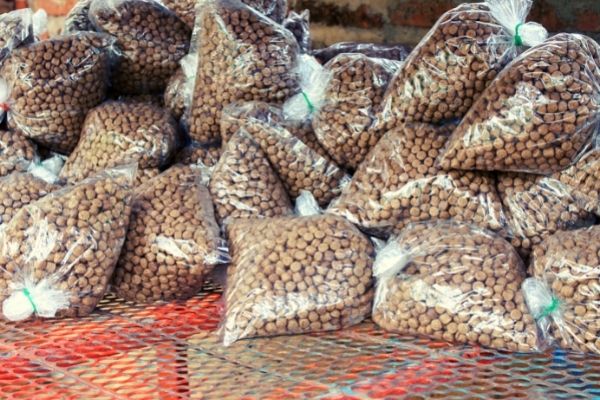
These feeds do have species-specific feeds available. However, to ensure your fish get all the required nutritional value, you have to look at the nutrient table or ingredients on the container. You then have to compare the values of the protein, vitamins, minerals, and other nutrients that your fish need with the amount in these feeds and then compensate for any low nutrients with supplements as needed. For example, you might need to add a fiber supplement to the feed as processed food does not have enough fiber.
The added benefit of using commercially processed fish feeds is that it has preservatives that allow you to buy in bulk, and you won’t have to worry about the feed going rancid before you can use it. It will also last longer than flaked food and powdered food.
You can put your fish feed in airtight containers in a dark place to avoid contaminants from entering the feed for added protection. The airtight container will also help the feed keep its flavor, and the nutrients as fish food could become stale quicker the longer it is left open.
Pelleted Fish Feed
When you buy a specialized fish feed from a fish feed manufacturer, you will get thee types of pelleted food; floating pellets, mid-level floating pellets, and sinking pellets. The kind you will choose depends on where the fish you have live.
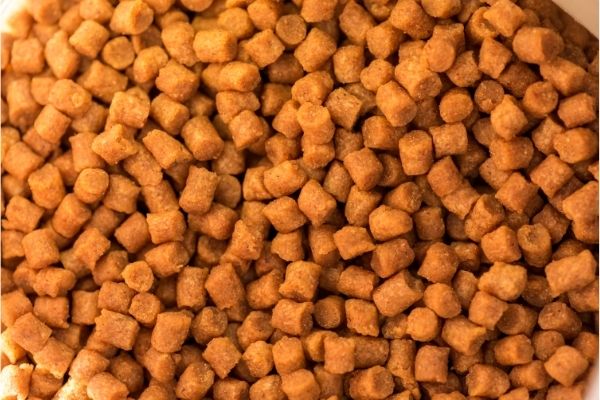
The floating pellets are suited for the fish who feed at the surface level, the mid-level feed is for the fish that don’t like to go up to the water’s surface to feed, and the sinking feed is best suited for the bottom feeders. Pelleted food also decomposes slower, so the fish has more time to eat the food before it disintegrates and has to be removed.
A few examples of fish that feed on floating pellets are silver Hatchet fish, glass catfish, and butterflyfish. A few examples of mid-level feeders are Angelfish, The Tiger Barb, Pearl Gourami, and Guppies. Finally, a few examples of bottom feeders are catfish, shrimp, tilapia, and carp.
Flaked Food
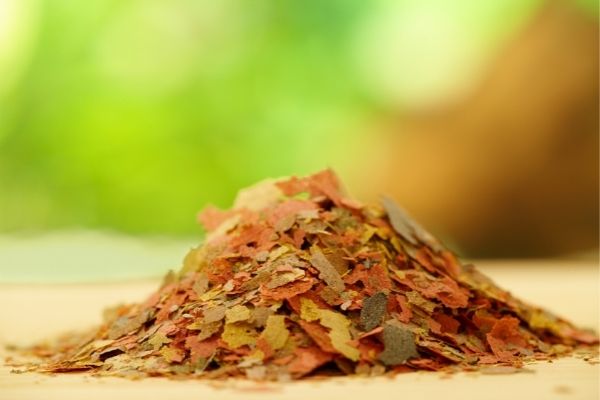
Flaked Fish Food
Flaked food is a popular choice of feed but is best suited for aquarium fish but not best for farmed fish. Flakes float on the top of the water and slowly sink, giving most fish a chance to eat food before it gets to the bottom.
Powdered Food
Powdered food is usually fed to juvenile fish as it is easy to digest. You can throw the powder directly onto the water or mix it with water and then pour it into the pond. However, the feed can easily pollute the water. That means you need to be careful not to overfeed the fish and remove the excess as soon as your fish are fed.
Freeze Dried Fish Food
Freeze-dried fish food is an excellent source of all the vitamins and minerals that your fish need. They are formulated to give all the nutrients your fish will need, including enough fiber. They are more expensive, but you might consider using freeze-dried food if you want the best food for your fish.
Frozen Fish Food
Frozen food has most of the nutrients your carnivorous fish need; they also contain fewer pathogens that might make your fish sick. In addition, frozen food is much less expensive than some other foods.
The Age Of Your Fish
The age of your fish will also determine the kind of feed and the amount of feed they need. During the growing phase, fish will eat different food from fully grown fish. Grown fish also have different nutritional needs than younger fish.
Conclusion
When you are buying feed for your fish farm, there are certain considerations that you need to make to give your fish the best possible feed to keep them strong and healthy. The age, the species of fish, the kind of feed, and where your fish live will all play a significant role when choosing the best possible feed for your fish farm.
